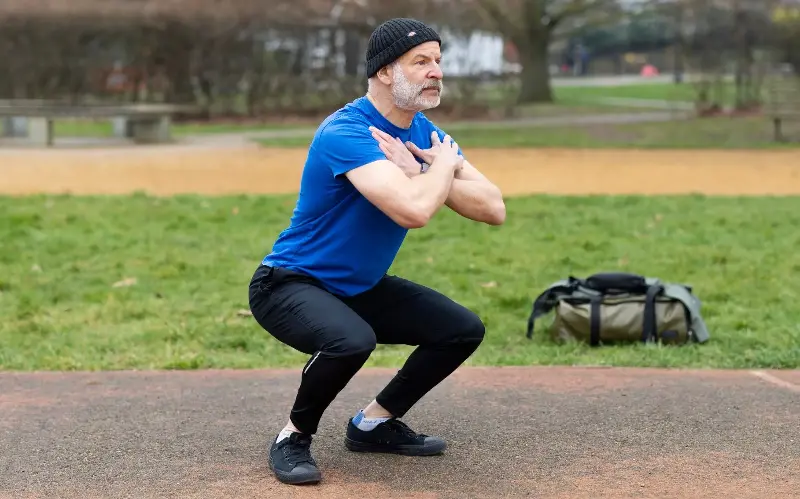
Sleep comes easily to me: in meetings, while filling out online forms, at the ballet, when anyone explains anything connected with personal finance. However, once in bed, a lot of this natural gift leaves me. You will often find me pointlessly lively between 3am and 4am, having woken up half-bonkers with worries about anything from roof repairs to our purpose on earth.
One thing that has always helped is my sessions lifting weights in the gym. There is something uniquely exhausting about strength training and, at 61, I now do something taxing with my muscles at least three times a week. These are the nights when my wake-ups are less disturbing and finding the door that leads back to dreamland is easier.
And now it seems that science is on my side. Newly published analysis carried out in Mahidol University, Bangkok, found that among older people (the over-60s) with insomnia, strength training – lifting, pushing and pulling – is superior to aerobic work as a means of improving slumber.
One theory behind this is that tensing and relaxing our muscles may resemble a classic and very effective late-night sleep technique.
Why is strength training so helpful for sleeplessness?
Prof Kevin Morgan of the Loughborough University Clinical Sleep Research Unit has been working on sleep for decades. He says progressive muscle relaxation (PMR) – the scrunching and relaxing of muscle groups across the body, is much like the action we perform while resistance training.
The technique involves clenching, holding and unclenching muscle groups. Recommended by the NHS, among others, the process can start at the feet, move up to the calves and culminate at the head, for example, leaving us loose and open to sleep. It was developed in the US at the start of last century and is now common practice as a remedy for insomnia.
Prof Morgan speculates that weight training may mimic the effect of PMR (each exertion is a brief hold, tense and release) and suggests that if you wanted to maximise this, it may be worth working the larger muscle groups. Once this is completed, he says, “bigger muscles may be more relaxed than they otherwise would be”.
Why timing is so important
If you want to maximise the power of your resistance training as a sleep aid, it’s worth thinking carefully about timing your sessions in a regular slot every day. Because exercise is such a powerful body-clock leader, picking a time and sticking to it is more important than when you do it. Sleep scientists have discovered that muscles contain their own circadian clocks and that exercise, along with light and food, is one of the ways our bodies orient themselves in time.
Prof Morgan says, if you want better sleep, “do exercise at a regular time and that will provide your circadian rhythm (your internal alarm clock) with a timing cue, so when you’re lying in bed your body now knows it’s night-time.” A study carried out by Dalian University, China, found movement can be a truly effective way of establishing healthy sleep patterns. “Exercise can regulate the body’s internal rhythms to a certain extent, making it possible to become a non-drug intervention for preventing and treating circadian rhythm disorders.”
However, experts recommend keeping intense workouts away from bed time. Exertion is a stress on the body, raises temperature and creates exciting chemicals that interact poorly with sleep.
The best time of day to exercise
Max Kirsten, a hypnotherapist and sleep coach, says: “Exercise in the morning. Exercise needs a few hours’ wind down, otherwise one has a higher heart rate and elevated adrenaline. If you want to drift off, it’s more of stimulant than a relaxant.” Just how late you can leave your exercise depends on how intense you work out. Something very gentle is unlikely to interfere with sleep but a HIIT session may need three hours or more.
The best exercises for sleep
Try this simple, no weights, strength workout designed by Connor O’Brien, the owner of gym group Absolute Body Solutions. It may help you sleep through the night and stay alert during that next self-assessment tax form.
1. Split squat
Muscles worked: Quads, glutes
- Starting with your feet hip width apart, take a big step forwards maintaining your hip width (think train tracks, not a tightrope).
- Lift your heel off the ground on your back leg. Keep your chest up and look straight ahead.
- Bend your front knee and push your hips forwards until your knee passes over your toes as much as it can without your front heel lifting off the ground.
- If your heel lifts up try putting a wedge or a small plate under your heel. Aim to keep your torso upright so it moves forwards and down. Your back leg bends as you lower yourself down, the more flexible you are the straighter you can keep it.
- Push the floor away with your front leg, keeping your torso upright and moving backwards and up to return back to your start position.
Why not try
Putting your front foot on a slightly elevated surface to target the side of your glutes and make it easier to push your knee over your toes. You could also add a resistance band.
2. Press-ups
Muscles worked: Chest, triceps
- Start with your hands slightly wider than shoulder with apart, your hips in line and your body straight.
- If needed, start from your knees, but keeping your hips in line.
- Bend your elbows and lower your chest to the floor.
- Push yourself back up strong too the start position.
Why not try
Turning your biceps in towards each other as you press up for a more effective contraction of the chest and triceps.
3. Squat
Muscles worked: Quads, hamstrings, glutes
- Stand tall with your feet shoulder width apart. Have your heels elevated with a wedge or plate if needed for improved range of motion.
- Bend your knees slowly and focus on lowering yourself down towards the floor (slowly).
- When at the bottom of the rep, push upwards, driving the floor away to stand up.
- Make sure you push through a flat foot and you aren’t allowing your heels to lift off the floor. Keep your chest up as you are standing up.
Why not try
Not resting at the top and keeping all the tension you’ve accumulated in your legs for the entire set.
Be careful of
- Bouncing out of the bottom
- Going too low
- Not going low enough
